Chapter 4, Part 20
Myanmar, formerly known as Burma, is a land that gave birth to great kings who ruled some of the mightiest empires in the history of Southeast Asia. Anawrahta established the first Burmese empire in the 11th century, a regional power that would last for more than two centuries. Today the surviving remnants of the Pagan Empire are scattered all over the plains of Bagan. In the 18th century, more than four centuries after the demise of the empire and a time when European powers began exerting their dominance in Asia, a new dynasty was founded by Alaungpaya. From the village of Shwebo, he organized a resistance movement against the French- and British-backed Hanthawaddy kingdom.
Following the victory of Konbaung – the new dynasty – over Hanthawaddy, Alaungpaya reunified Burma and ruled his kingdom from the very village he was once chief. However, upon his death eight years after the establishment of the dynasty, the capital of the kingdom was moved much closer to the Ayeyarwady (Irrawaddy) river, to the city of Sagaing. For over a century, due to religious and political reasons, successive Konbaung kings moved the capital to several other places within a 10 km of radius of the river bend. From Sagaing the palace was moved to Ava across the river, then to Amarapura to the northeast of Ava which served as the kingdom’s capital until 1859.
In 1853, a new king ascended the throne. Mindon replaced his half-brother, Pagan, who lost the Second Anglo-Burmese War a year earlier, resulting in the annexation of Lower Burma by the British. The new king spurred nationwide modernization by sending Burmese scholars to Europe to learn about state administration and economic management. Reforms were made soon afterward, encompassing multiple aspects within the kingdom, including the judicial system, trade, armed forces, bureaucracy and taxation. All of this were done partly to counter the increasing threat imposed by the British to the south.
Four years since becoming the king of Burma, King Mindon commissioned the construction of a new palace in Mandalay, directly to the north of Amarapura. However, as his kingdom had not completely recovered from the loss in the war against the British, instead of building an entirely new palace, Mindon ordered the old palace in Amarapura to be dismantled and transported to Mandalay – the new capital – where it would then be reassembled. One of the sections of the old palace was eventually moved to what is now known as Shwenandaw monastery. It initially occupied the northern part of the new palace’s main structure – also called the Glass Palace – where King Mindon and Thibaw, his son and successor, lived. But the latter relocated the monastery to a place outside the moat-surrounded palace compound because he believed it was haunted by his father’s spirit after his death.
From his palace in Mandalay, King Thibaw ruled the kingdom for only seven years, from 1878 until 1885, when he was defeated in the Third Anglo-Burmese War. It is an event remembered in Burmese history as the end of centuries of Burmese monarchies, with the Konbaungs the very last dynasty to have ever ruled the country. Burma was then absorbed into the British Raj and officially became a province of India. The palace in Mandalay was looted by the British, and the royal library burned down.
During World War II, the Japanese took control of Mandalay and other parts of Burma from the British, and the strategically-located citadel of the former palace in the city was turned into a supply depot. However, as the Allied forces struck back to regain their colonies, they bombed the citadel and everything within its vicinity, sparing only the royal mint and the watch tower. Thanks to the unexpected relocation of Shwenandaw monastery out of the palace decades earlier, it survived the bombings and now stands elegantly in a neighborhood to the northeast of the former palace grounds.
Restoration work on the former royal palace in Mandalay began in 1989, the same year when the military junta changed the name of the country from Burma to Myanmar. As the junta was dissolved in 2011, opening a pathway to much-needed democratic reforms in the country, places all over Myanmar, including Mandalay, began receiving foreign tourists in droves.
At first sight, Mandalay is devoid of the impressive colonial buildings that line the streets of Yangon. Instead, uninspiring multi-story residential buildings and shops dominate the skyline. The overall atmosphere of the city in a way reminds me of Medan, Indonesia’s fourth-largest city with rough edges and unforgiving drivers. We have probably been spoiled after seeing some of Myanmar’s most inspiring ancient sites a week earlier. However, our not-so-positive impression of Mandalay is quickly redeemed by the dishes we sample, including the best mohinga (rice noodles in fish soup served with boiled egg and fritters, considered the national dish of Myanmar) I’ve ever tried, as well as se pe oo thoke made from sliced tomatoes, onion and garlic, mixed with translucent preserved eggs (also known as century egg). On the street, one particular stall tended by a husband and wife sells a type of snack typically served at festivals. Indeed, our visit to Mandalay has coincided with the full moon of Thadingyut, marking the end of Buddhist lent. Called molimiya, the half-dome fried snack poetically signifies a couple as two halves that are served together.
Mandalay may not be our favorite place in Myanmar, but the mohinga we enjoy is enough reason for me to consider a second visit in the future. Soon the city’s skyline might forever change with the addition of even taller buildings. But to the south, along the banks of the mighty Ayeyarwady, the vestiges of the nation’s last dynasty will hopefully be forever left in peace.
Click here for the full list of stories from the Spice Odyssey series.
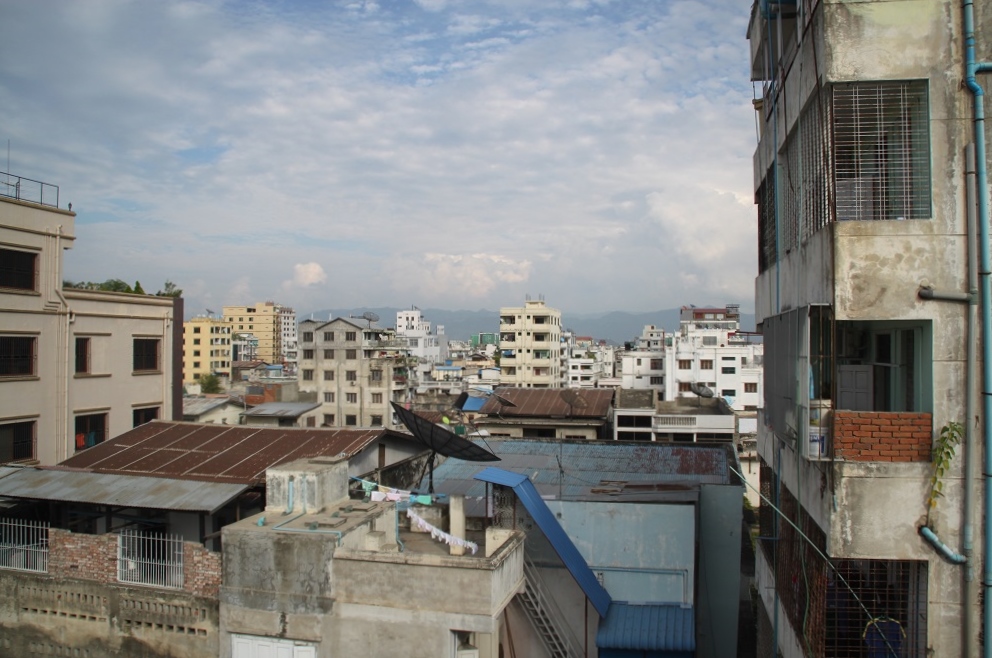
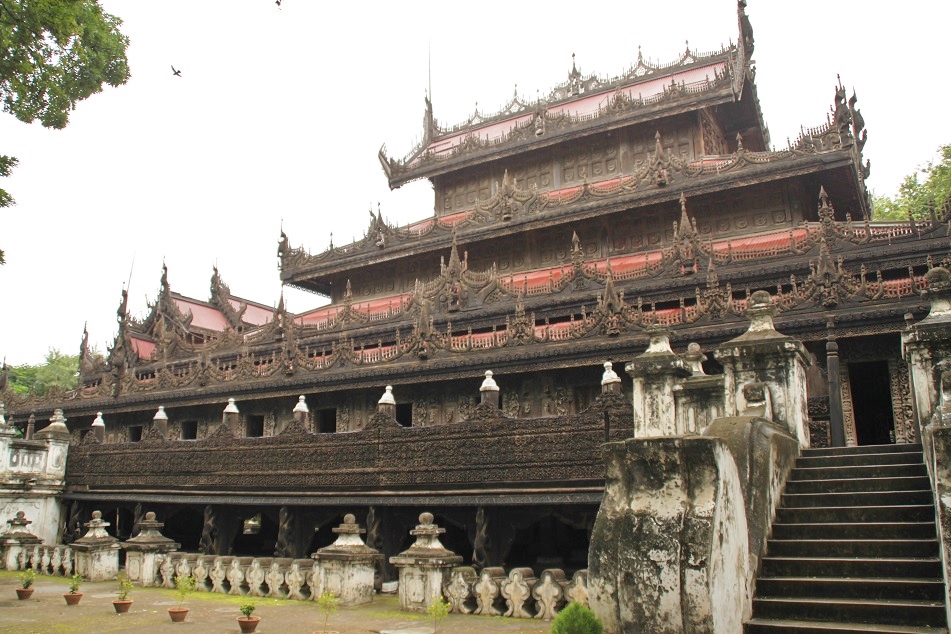

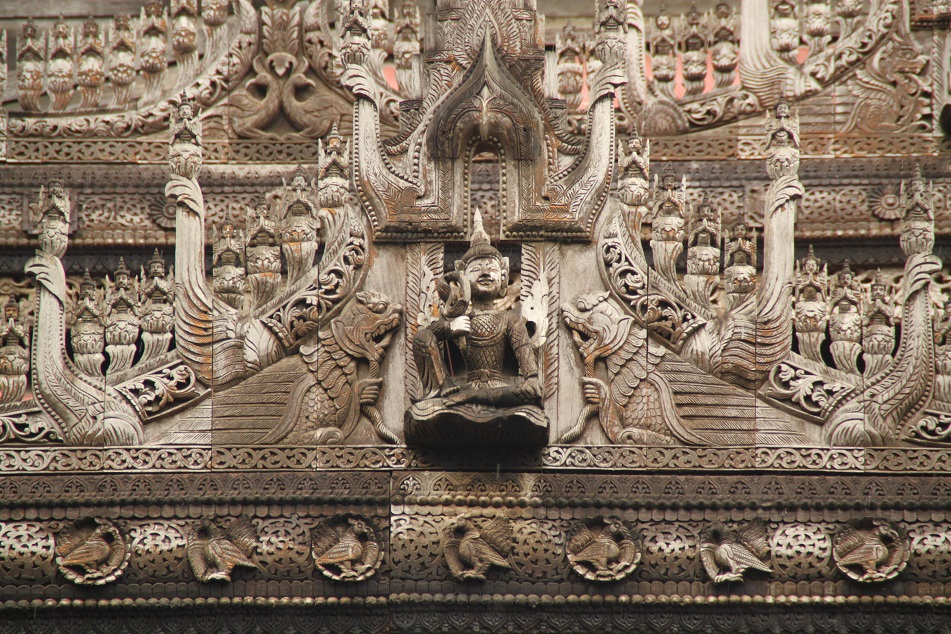


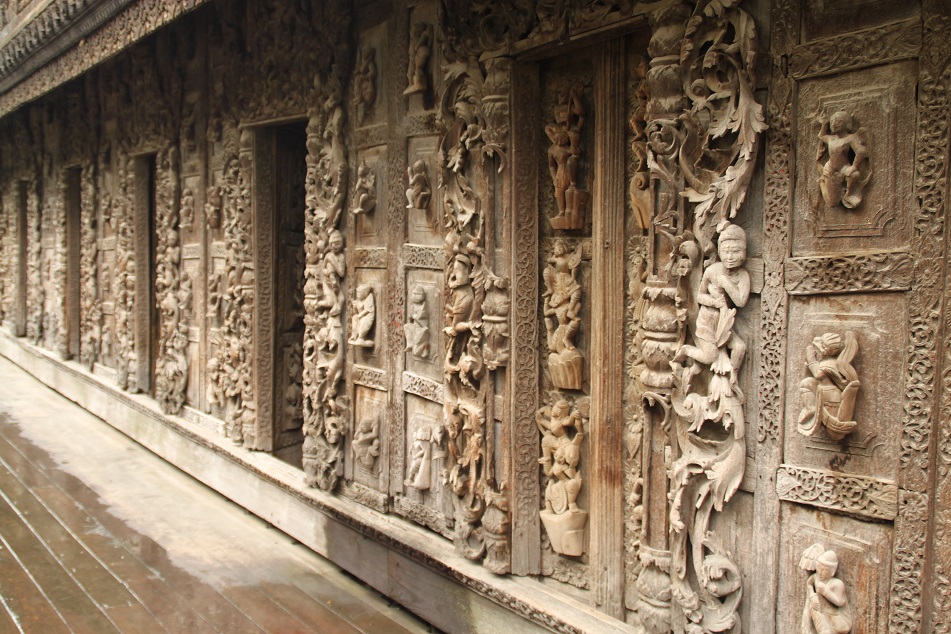

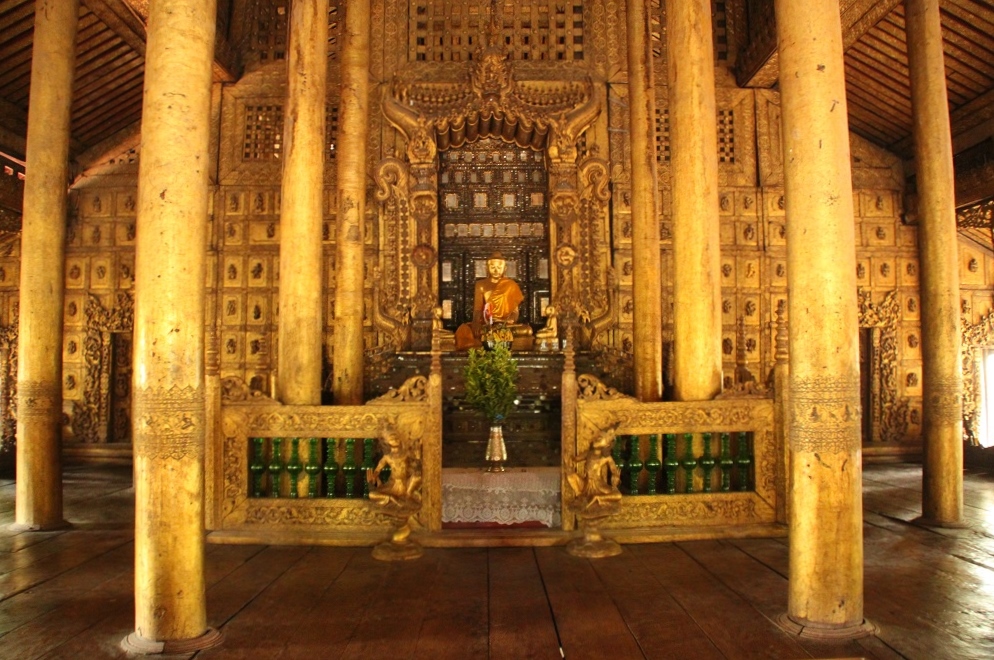
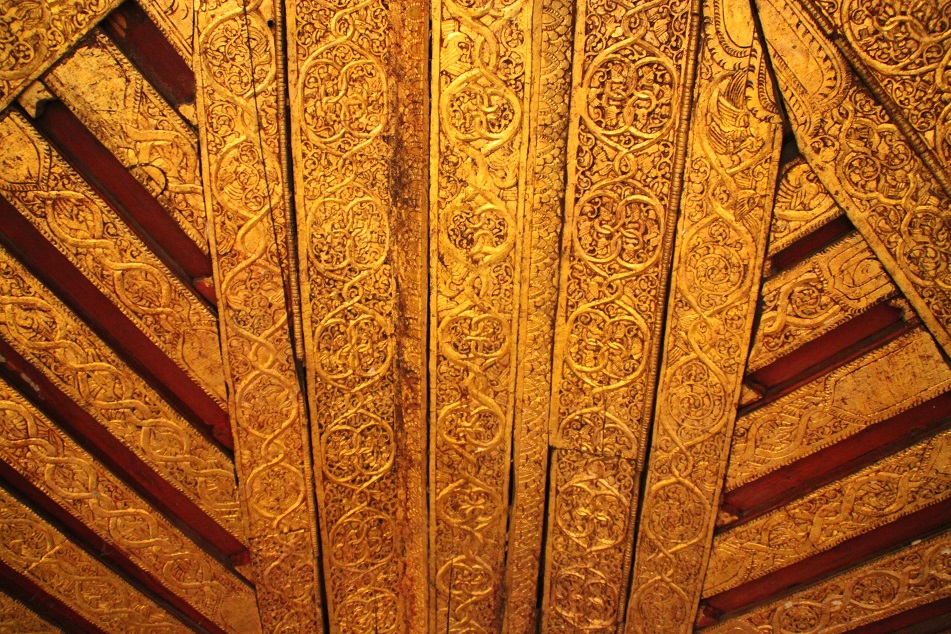




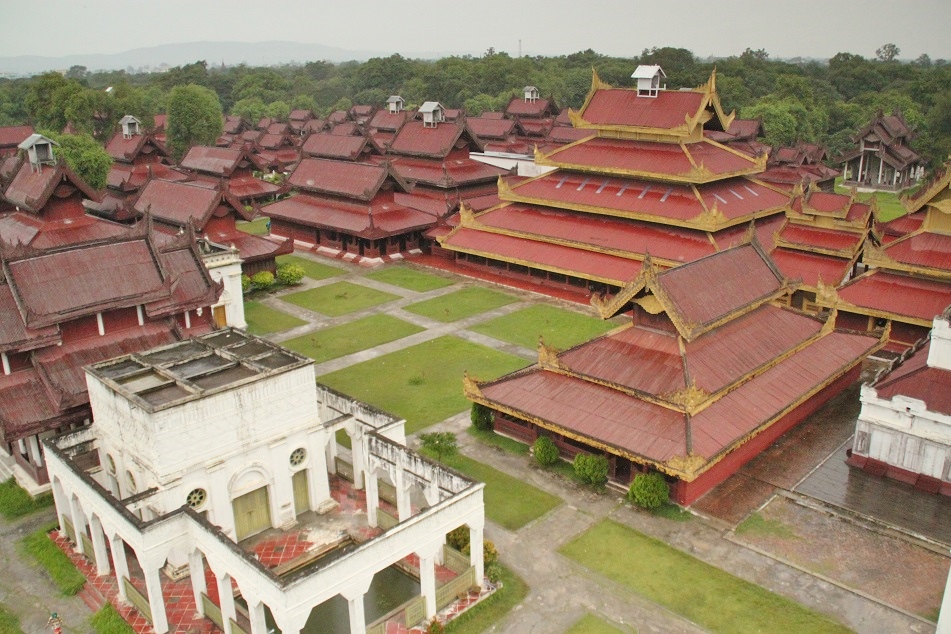
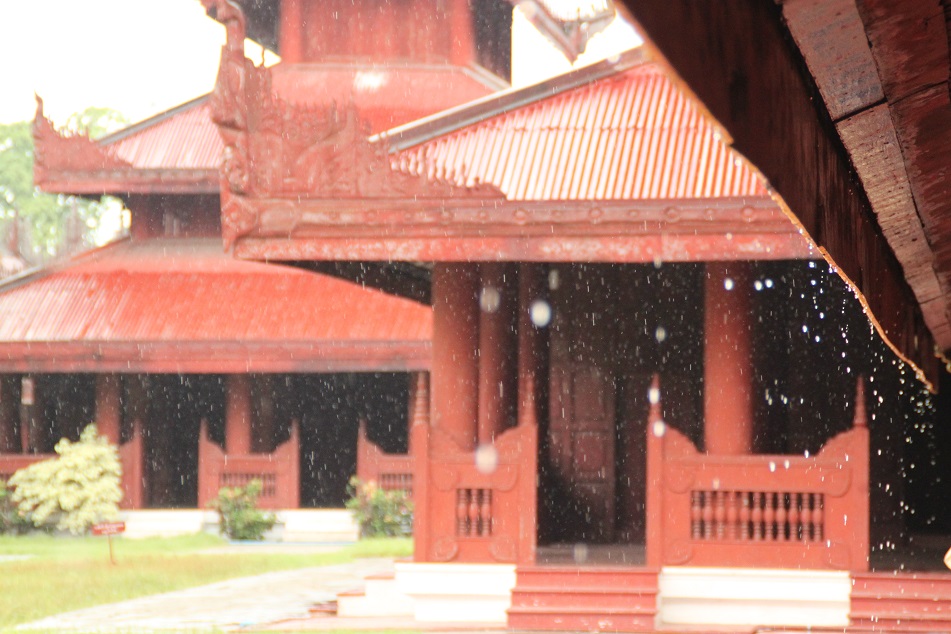
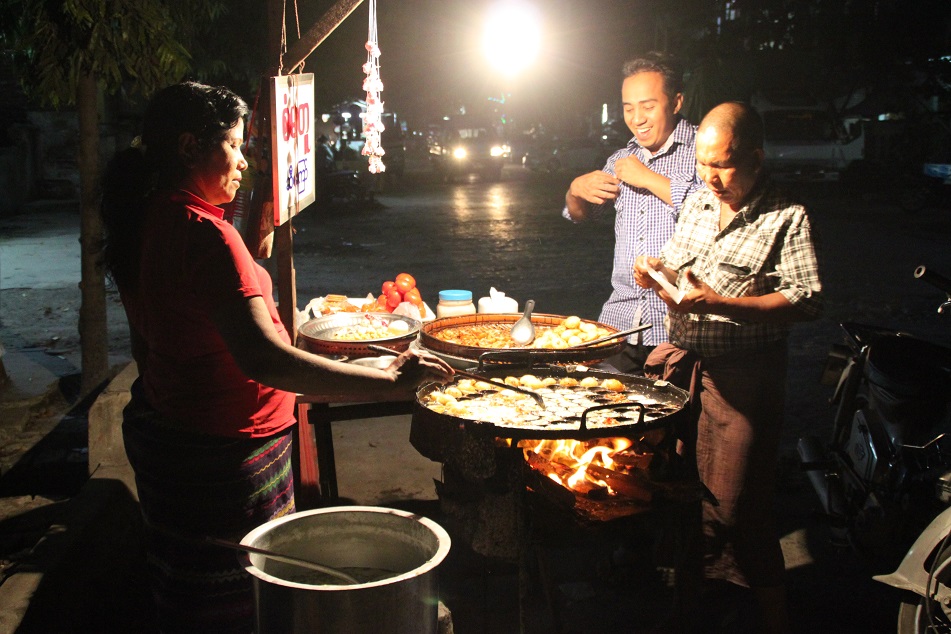

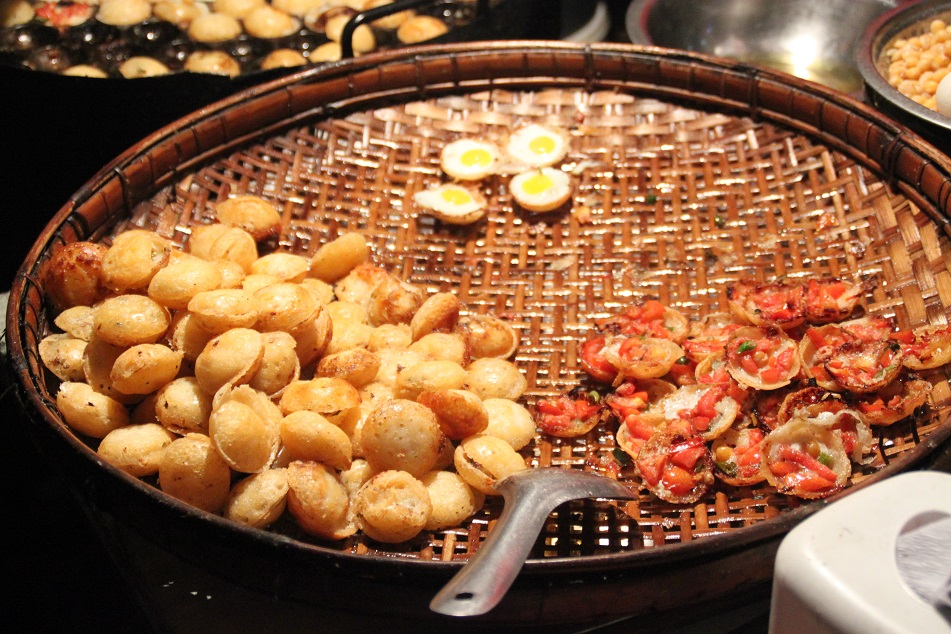
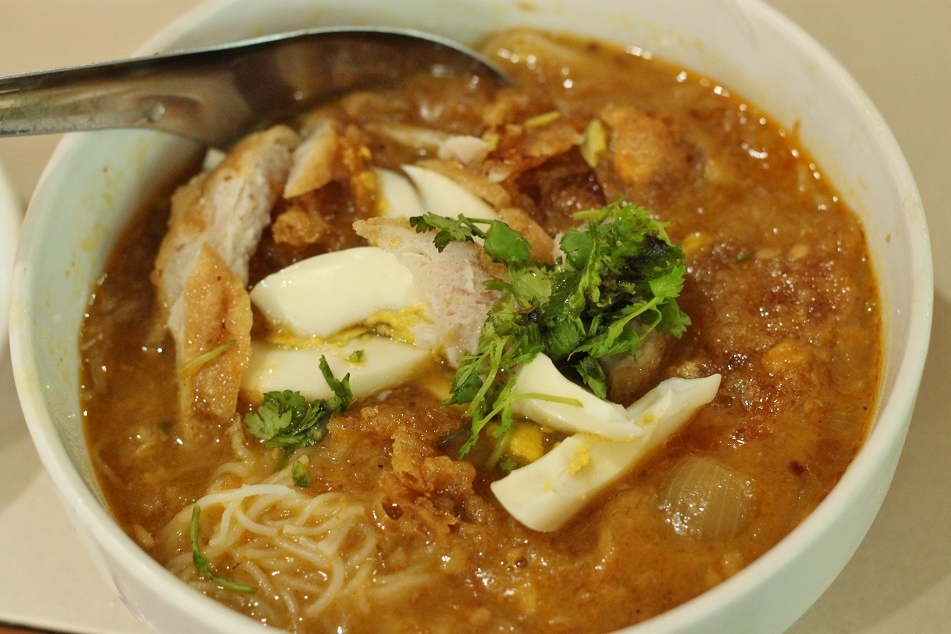

Lovely post and pictures
LikeLike
Thanks! Always appreciate your kind comment.
LikeLiked by 1 person
you are welcome 🙂
LikeLike
Mas Bamaaaaa…. dikau mengingatkan perjalananku yang menyenangkan banget di Mandalay… Shwenandaw, tempat yang harus aku lompat-lompat kanguru karena lantai kayu itu panas banget kalo udah lama disinari matahari dan harus mundur ga boleh deket2 altar karena aku perempuan. Trus liat foto para isteri Raja Mandalay yang buaaanyaaaaaakk banget di istana itu sampai cheating naik mobil ke Mandalay Hill krn ogah naik tangga bwahahahaha… tapi setuju banget Mandalay itu asiiiiik banget…
LikeLike
Mbak Riyantiii.. 😀 Iya saya ingat kok postingannya Mbak Riyanti mengenai Mandalay, dan habis baca kerasa banget excitement-nya Mbak Riyanti di sana. Next time kalau saya balik ke sana pengen banget ke Sagaing dan Ava untuk mengunjungi peninggalan Dinasti Konbaung. Sayang kemarin pas di Mandalay hujan terus, jadinya lebih fokus ke makan deh, hehe..
LikeLiked by 1 person
Goodness, just amazing, vibrant detail. I could linger for hours in there.
LikeLike
I took too many photos of the monastery. If it wasn’t raining, I would have taken more! The wood carvings were so beautiful and exquisite.
LikeLike
Dude! This is amazing!
LikeLike
Thanks! I guess that means you should put this place in your wishlist.
LikeLike
Great post and photos of Mandalay, which my husband and I actually enjoyed when we were in the country a few weeks ago. It was not so much the city itself, which you rightly say, lacks the charm of Yangon, but the temples which we found more unique and interesting, and the areas nearby (Mingun, Sagaing). We found the markets in Mandalay more interesting, and the restaurants very good. Those molimiya look awesome — I didn’t have the luck to see them while there. Missing Myanmar already!
LikeLike
Maybe if the weather was better, my friend and I would have explored Mingun and Sagaing as well, and my perception of Mandalay would have been different. But that means it deserves a second visit, doesn’t it? During our stay in the city, we frequented this street side restaurant which was always lively. They served some of the best salads — Burmese salad that is — in the country. Next time you visit Mandalay, that mohinga place is to the southeast of the palace. Thanks for reading!
LikeLike
I must look at this several more times. Such detail! Great job.
LikeLike
And that incredibly ornate monastery was once part of the palace. Imagine how the original palace compound would have looked like had it been spared from the bombing.
LikeLiked by 1 person
I thought of all the hands that did the carvings.
LikeLike
More and more people today need to learn such craftsmanship, partly to help conservation efforts of old buildings all over Asia and beyond.
LikeLiked by 1 person
Thanks for another glimpse into the fascinating history of this corner of the world. I can’t imagine dismantling that spectacular ornate palace and moving it, and I can see why you couldn’t stop taking photos of the fantastic carvings! I wonder if such artwork will ever be produced again. Seems history is marked by building and destroying, which is certainly happening at the moment. Think of what could be done for people if all that money were used for purposes such as clean water…
I like the wood stove used by the street vendors.
Great post.
LikeLike
It’s always a pleasure to share the stories from my side of the world to yours, Marilyn. I guess conscience is part of the reason why building such an elaborately decorated building — which always incurs a hefty sum of fortune — is less favorable these days for the same amount of money can bring greater good to the society. However, preserving such craftsmanship is equally important. Thanks for reading and sharing your thoughts!
LikeLike
Pingback: Myanmar – ANAK SINNGKONG
We in the West know next to nothing about the great cultures of the Far East. The images illustrate the power, splendor and glory of Burmese ancient empires. Thanks for your contribution to fill a gap in our Western consciousness!
LikeLike
Asia is indeed one big continent with rich cultures and history, and that is part of the reason why I keep coming back to some of the countries in the region. However, the Occident intrigues me with equal proportion. The blogging world provides windows for us to get a glimpse of each other’s life and customs, and that’s why I love it. I sincerely appreciate your comment, Peter. I’m glad my blog contributes to filling that gap, as others do to mine.
LikeLiked by 1 person
I love your captures of the intricate teak carvings at Shwenandaw, which in a way remind me of the temple ruins at Siem Reap, Cambodia. As you say, after seeing the stunning art and architecture of these ancient cities, it is hard to reconcile the modern day parts!
LikeLike
Aren’t they sublime? Speaking of Siem Reap, there’s one temple that I missed on my visit there but I really want to go: Banteay Srei. I believe you went there, didn’t you? Can you imagine how much more colorful and beautiful the world would have looked like if most of the ancient temples that had been constructed had survived the test of time!
LikeLike
Hello Bama, how interesting is the history of Southeast Asia, thank you for sharing this part of the world with us with your perspective and pictures.
LikeLike
Thanks Liz. I’m equally intrigued by your part of the world — I’ve been dreaming to visit ancient sites in the Americas.
LikeLiked by 1 person
That’s good news! I would be delighted to share with you what I know about ancient sites in the Americas when you decide to visit here ☺
LikeLike
Thanks for that, Liz!
LikeLiked by 1 person
Seperti biasa, tulisan dan foto yg indah! Terimakasih sudah menulis dan memotret ♥
LikeLiked by 1 person
Terima kasih juga sudah meluangkan waktu untuk membaca blog saya!
LikeLike
Bama, this is a fascinating historical account with lovely photos to match. Even in the rain, Shwenandaw was truly a sight to behold! It makes you wonder just how ornate and captivating the original “Glass Palace” must have been in its heyday. I’m also curious about what material the Burmese used on the palace/monastery roofs before corrugated iron sheets were introduced.
LikeLiked by 1 person
Thanks James! I can imagine the Glass Palace as one magnificent abode of Burmese kings which mesmerized and astounded foreign dignitaries alike. It’s such a shame that there are other places in the world which also suffered heavy damage from bombings. Speaking of the roofs of Shwenandaw, I believe the monastery would have looked even more beautiful had they used the same material for the roofs as the original. But that would have cost too much, I guess.
LikeLiked by 1 person
Good food makes good mood, hehe.
I adore Burmese architecture. As you said, no corner left unadorned, even at a tiny single unimportant part of the building.
LikeLiked by 1 person
That especially works for Indonesians since we do love snacking and eating! 🙂
Isn’t that monastery marvelous? There’s something very appealing about ancient edifices with intricate carvings on them.
LikeLike
Yes, so marvelous and.. Divine!
LikeLike
wow, thats good picture with authentic culture
LikeLiked by 1 person
Thank you mas.
LikeLike
So interesting and authentic post! Nice photos. Bye. Kamila
LikeLiked by 1 person
Thanks Kamila! Always appreciate your kind comments.
LikeLiked by 1 person
Jadi kalo kangen Mandalay bisa ke Medan dong biar deket? 😀
Setuju, saya pun gak keberatan pergi ke satu tempat lebih dari sekali. Apalagi kalo kelewatan tempat macam Banteay Srei dan Mingun gitu ya? Candi pink dan reruntuhan itu emang menggoda banget!
LikeLiked by 1 person
Haha, ya gak juga sih. 😀 Eh tapi di dekat Berastagi ada replika Shwedagon sih. Hmm, baru kepikiran kalau ada beberapa hal di Sumatra Utara yang sedikit banyak mengingatkan akan Myanmar. Wah iya, Banteay Srei dan Mingun itu dua dari sekian banyak reruntuhan kuno di Asia Tenggara yang saya bener-bener pengen kunjungi! Buat saya candi-candi itu menarik karena biasanya saya membayangkan gimana kehidupan orang-orang di waktu candi-candi tersebut masih berdiri megah. Suka terbawa imajinasi jadinya. 🙂
LikeLike
Thanks for sharing us… your pics truly allowed us to travel to Mandalay. I simply loved the intricacy of these sculptures. I feel like ancient sculptors are like a thousand times better than today’s.
LikeLiked by 1 person
Thank you, Dr. Y.! I wonder if the sculptors who created those intricate carvings at the monastery thought about the same thing, that sculptors long before their time were far more skillful than them.
LikeLiked by 1 person
kemarin ke Myanmar bulan berapa, Bama? aku lagi browsing2 kapan best time to visitnya, nih. Yang ga terlalu panas n ga banyak ujan #banyakmaunya :))
Ohhh those food looks really yummeh, yah. Makin inginnnnn melipir ke Myanmar. Kemarin cuma sempet dadah dadah dari Mae Sai border di Chiang Rai, hahaha
LikeLiked by 1 person
Waktu itu bulan Oktober, which was kurang lebih akhir musim hujan di sebagian Myanmar. Selama di Yangon sih sempet hujan sebentar, tapi sisanya cukup cerah (bisa dilihat foto-fotonya di postingan yang aku bakal publish besok pagi, hehe). Terus di Bagan cuma hari pertama aja yang berawan, sisanya cerah. Di Inle Lake juga mostly cerah. Baru pas nyampe Mandalay ini cuacanya kalau gak hujan ya mendung terus.
Eh btw Chiang Rai sama Chiang Mai itu dua kota di Thailand yang pengen banget aku kunjungi nih. Semoga bisa nyusul ke sana segera. 🙂
LikeLike
Pingback: Bangkok and the Anglo-French Tug of War | What an Amazing World!
This place has some specific kind of magic, I cannot explain it with words! Thanks a bunch for such an amazing post, Bama!
LikeLiked by 1 person
Hi Agnes! Despite its rather uninspiring city center, Mandalay really deserves a visit since it is also conveniently located not far from some of Myanmar’s most interesting historical places — and it has the best mohinga in the country. Appreciate your time dropping by my blog!
LikeLike